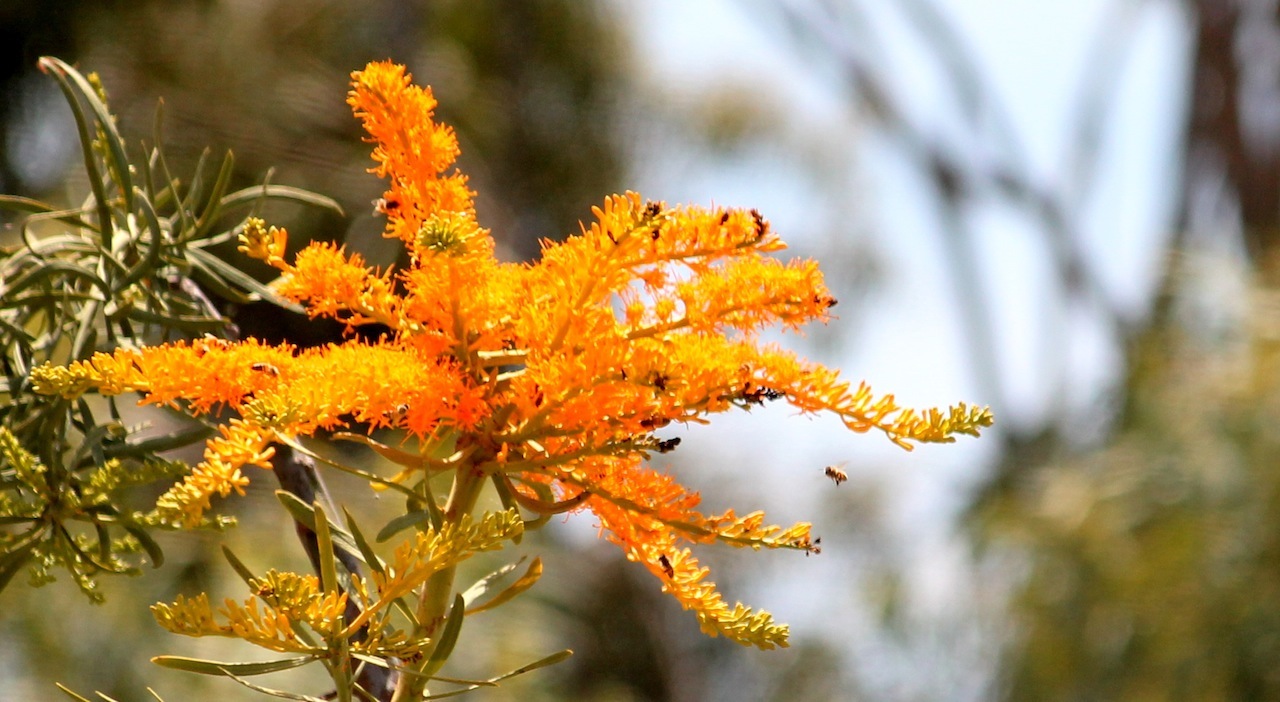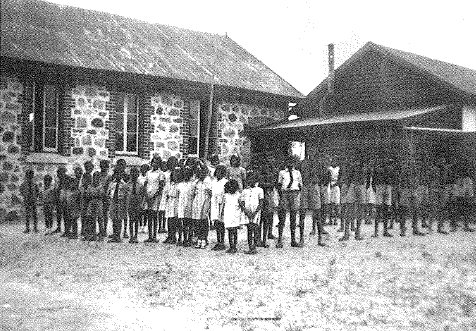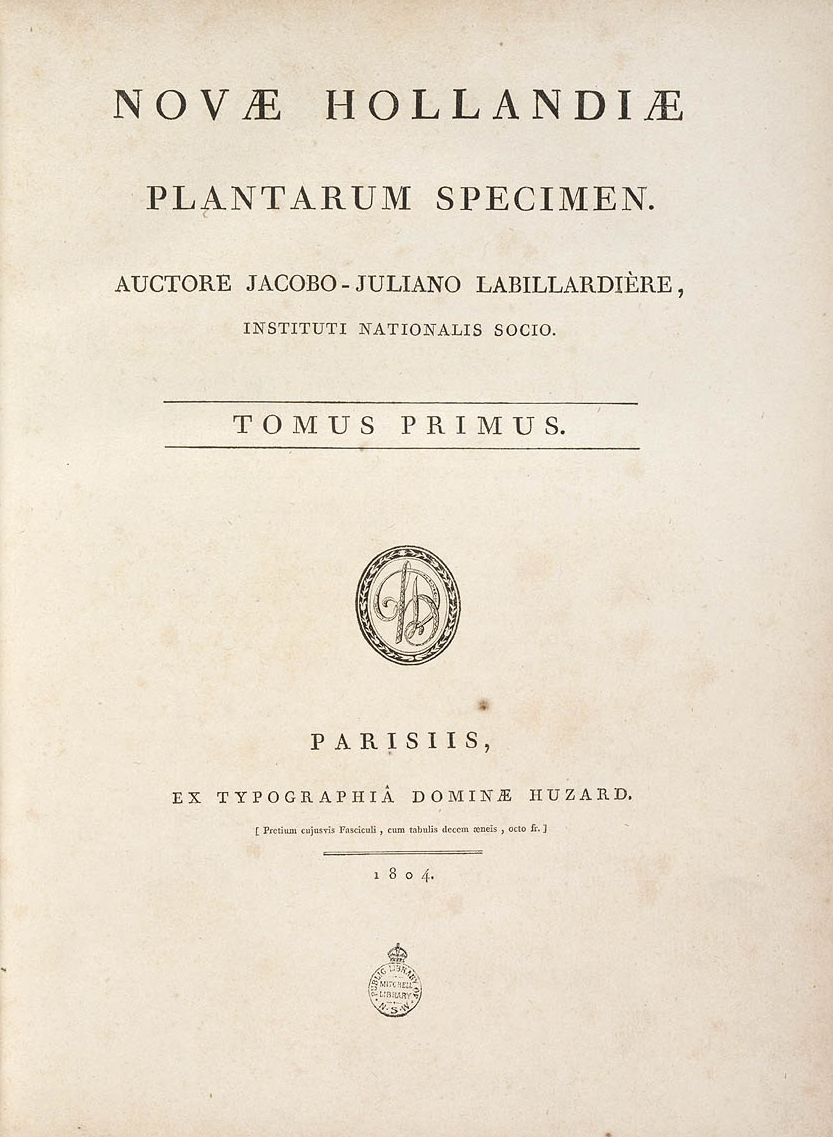|
Nuytsia Floribunda
''Nuytsia floribunda'' is a Hemiparasite, hemiparasitic tree found in Western Australia. The species is known locally as moodjar and, more recently, the Christmas tree or Western Australian Christmas tree. The display of intensely bright flowers during the austral summer coincides with the Christmas season. Description The habit of the species may be a tree up to high, or as a lower-growing shrub. The rough Bark (botany), bark is grey-brown. Flower, Flowers are a vivid, yellow-orange, appearing sometime between October and January. The inflorescence on each flowering stem may be up to in length. This species is a root hemiparasite, is Photosynthesis, photosynthetic, and mainly obtains its water and mineral nutrients from its hosts. The haustorium, haustoria arising from the roots of ''Nuytsia'' attach themselves to the roots of many adjacent plants, drawing water and nutrients from them. Almost all other nearby species are susceptible to attack; haustoria have even been foun ... [...More Info...] [...Related Items...] OR: [Wikipedia] [Google] [Baidu] [Amazon] |
Robert Brown (Scottish Botanist From Montrose)
Robert Brown (21 December 1773 – 10 June 1858) was a Scottish botanist and paleobotanist who made important contributions to botany largely through his pioneering use of the microscope. His contributions include one of the earliest detailed descriptions of the cell nucleus and cytoplasmic streaming; the observation of Brownian motion; early work on plant pollination and fertilisation, including being the first to recognise the fundamental difference between gymnosperms and angiosperms; and some of the earliest studies in palynology. He also made numerous contributions to plant taxonomy, notably erecting a number of plant families that are still accepted today; and numerous Australian plant genera and species, the fruit of his exploration of that continent with Matthew Flinders. Early life Robert Brown was born in Montrose, Scotland on 21 December 1773, in a house that existed on the site where Montrose Library currently stands. He was the son of James Brown, a mi ... [...More Info...] [...Related Items...] OR: [Wikipedia] [Google] [Baidu] [Amazon] |
Nuytsia Floribunda MRDonald Nuytsia Floribunda MRDonald DSC 4214 (23847113204)
''Nuytsia floribunda'' is a hemiparasitic tree found in Western Australia. The species is known locally as moodjar and, more recently, the Christmas tree or Western Australian Christmas tree. The display of intensely bright flowers during the austral summer coincides with the Christmas season. Description The habit of the species may be a tree up to high, or as a lower-growing shrub. The rough bark is grey-brown. Flowers are a vivid, yellow-orange, appearing sometime between October and January. The inflorescence on each flowering stem may be up to in length. This species is a root hemiparasite, is photosynthetic, and mainly obtains its water and mineral nutrients from its hosts. The haustoria arising from the roots of ''Nuytsia'' attach themselves to the roots of many adjacent plants, drawing water and nutrients from them. Almost all other nearby species are susceptible to attack; haustoria have even been found attached to underground cables. In natural settings, however, ... [...More Info...] [...Related Items...] OR: [Wikipedia] [Google] [Baidu] [Amazon] |
Western Mail (Western Australia)
''The Western Mail'', or ''Western Mail'', was the name of two weekly newspapers published in Perth, Western Australia. Published 1885–1955 The first ''Western Mail'' was published on 19 December 1885 by Charles Harper and John Winthrop Hackett, co-owners of ''The West Australian'', the state's major daily paper. It was printed by James Gibney at the paper's office in St Georges Terrace. In 1901, in the publication ''Twentieth century impressions of Western Australia'', a history of the early days of the ''West Australian'' and the ''Western Mail'' was published. In the 1920s ''The West Australian'' employed its first permanent photographer Fred Flood, many of whose photographs were featured in the ''Western Mail''. In 1933 it celebrated its first use of photographs in 1897 in a ''West Australian'' article. The ''Western Mail'' featured early work from many prominent West Australian authors and artists, including Mary Durack, Elizabeth Durack, May Gibbs, Stan ... [...More Info...] [...Related Items...] OR: [Wikipedia] [Google] [Baidu] [Amazon] |
Australian Town And Country Journal
''Australian Town and Country Journal'' was a weekly English language broadsheet newspaper published in Sydney, New South Wales, from 1870 to 1919. The paper was founded by Samuel Bennett with his intention for it to be "valuable to everybody for its great amount of useful and reliable information". The paper was known for its range of topics, dealing with domestic and foreign news as well as featuring essays on literature, science and invention. History The first issue of the ''Australian Town and Country Journal'' was published on 8 January 1870. The ''Journal'' ran until 25 June 1919. After 2 June 1878, when Samuel Bennett died, publication of the paper was taken over by his sons, Frank and Christopher. Digitisation The paper has been digitised as part of the Australian Newspapers Digitisation Program project of the National Library of Australia. See also *List of newspapers in Australia *List of newspapers in New South Wales This is a list of newspapers in New South ... [...More Info...] [...Related Items...] OR: [Wikipedia] [Google] [Baidu] [Amazon] |
Bushfire
A wildfire, forest fire, or a bushfire is an unplanned and uncontrolled fire in an area of Combustibility and flammability, combustible vegetation. Depending on the type of vegetation present, a wildfire may be more specifically identified as a bushfire (Bushfires in Australia, in Australia), desert fire, grass fire, hill fire, Peat#Peat fires, peat fire, prairie fire, vegetation fire, or veld fire. Some natural forest ecosystems Fire ecology, depend on wildfire. Modern forest management often engages in prescribed burns to mitigate fire risk and promote natural forest cycles. However, controlled burns can turn into wildfires by mistake. Wildfires can be classified by cause of ignition, physical properties, combustible material present, and the effect of weather on the fire. Wildfire severity results from a combination of factors such as available fuels, physical setting, and weather. Climatic cycles with wet periods that create substantial fuels, followed by drought and heat, of ... [...More Info...] [...Related Items...] OR: [Wikipedia] [Google] [Baidu] [Amazon] |
Mineng
Mineng, also spelt Minang, Minanga, or Mirnong, are an Aboriginal Noongar people of southern Western Australia. Name The ethnonym ''Minang'' is etymologized to the word for south, ''minaq'', which means that the tribe were defined as "southerners". Country The Minang's traditional lands encompassed some from King George Sound northwards to the Stirling Range. It took in Tenterden, Lake Muir, Cowerup and the Shannon River area. Along the coast their territory ran from West Cliff Point to Boat Harbour, Pallinup. Mount Barker, Nornalup, Wilson Inlet and Porongurup Range were also part of their territory. Social organisation The Minang were divided into groups (formerly known as "hordes"). A northerly group of these, known as the ''Munite'', may perhaps refer to the " White Cockatoo" tribe mentioned in other sources. History of contact Norman Tindale mentions a passage in Charles Darwin's '' Voyage of the Beagle'' that may reflect an encounter with the Minang. Descri ... [...More Info...] [...Related Items...] OR: [Wikipedia] [Google] [Baidu] [Amazon] |
Noongar
The Noongar (, also spelt Noongah, Nyungar , Nyoongar, Nyoongah, Nyungah, Nyugah, and Yunga ) are Aboriginal Australian people who live in the South West, Western Australia, south-west corner of Western Australia, from Geraldton, Western Australia, Geraldton on the west coast to Esperance, Western Australia, Esperance on the south coast. There are 14 different groups in the Noongar cultural bloc: Amangu, Ballardong, Yued, Kaneang, Koreng, Mineng, Njakinjaki, Njunga, Pibelmen, Pindjarup, Wadandi, Whadjuk, Wiilman and Wudjari. The Noongar people refer to their land as . The members of the collective Noongar cultural bloc descend from people who spoke several languages and dialects that were often Mutual intelligibility, mutually intelligible. What is now classified as the Noongar language is a member of the large Pama–Nyungan languages, Pama–Nyungan language family. Contemporary Noongar speak Australian Aboriginal English (a dialect of the English language) laced with Noong ... [...More Info...] [...Related Items...] OR: [Wikipedia] [Google] [Baidu] [Amazon] |
Pieter Nuyts
Pieter Nuyts or Nuijts (159811 December 1655) was a Dutch Exploration, explorer, diplomat and politician. He was part of a landmark expedition of the Dutch East India Company in 1626–1627 which mapped the southern coast of Australia. He became the Dutch ambassador to Japan in 1627, and was appointed governor of Formosa in the same year. Later he became a controversial figure because of his disastrous handling of official duties, coupled with rumours about private indiscretions. He was disgraced, fined and imprisoned, before being made a scapegoat to ease strained Dutch relations with the Japanese. He returned to the Dutch Republic in 1637, where he became the mayor of Hulster Ambacht and of Hulst. Nuyts is remembered today chiefly in the place names of various points along the southern Australian coast, named for him after his voyage of 1626–1627. During the early 20th century, he was vilified in Japanese school textbooks in Taiwan as an example of a "typical arrogant west ... [...More Info...] [...Related Items...] OR: [Wikipedia] [Google] [Baidu] [Amazon] |
Novae Hollandiae Plantarum Specimen
''Novae Hollandiae Plantarum Specimen'' is a two-volume work describing the flora of Australia. Facsimiles of the originals can be found in the onlinBiodiversity Heritage Library (Vol.1)anVol 2) The author was the French botanist Jacques Labillardière, who visited the region in 1792 with the d'Entrecasteaux expedition. Published between 1804 and 1806, it is one of the earliest works to describe the plants of the continent; according to Denis and Maisie Carr, " practical terms, this was the first general flora of Australia." The work describes the botanical collections made by himself and his companion on the d'Entrecasteaux expedition, Charles Riche, and the unattributed and later collections of Nicolas Baudin's expedition. Labillardière's collections were seized by the English, but were returned to him in France at the intervention of Joseph Banks. He made his collections at Observatory Island and other locations at the Archipelago of the Recherche. Extensive collection were ... [...More Info...] [...Related Items...] OR: [Wikipedia] [Google] [Baidu] [Amazon] |
Allan Cunningham (botanist)
Allan Cunningham (13 July 1791 – 27 June 1839) was an English botany, botanist and List of explorers, explorer, primarily known for his expeditions into uncolonised areas of eastern Australia to collect plants and report on the suitability of the land for grazing purposes. Early life Cunningham was born in Wimbledon, London, England, the son of Allan Cunningham (head gardener at Wimbledon Park House), who came from Renfrewshire, Scotland, and his English wife Sarah (née Juson/Jewson née Dicken). Allan Cunningham was educated at a Putney private school, Reverend John Adams (educational writer), John Adams Academy and then went into a solicitor's office (a Lincoln's Inn Conveyancer). He afterwards obtained a position with William Townsend Aiton superintendent of Royal Botanic Gardens, Kew, Kew Gardens, and this brought him in touch with Robert Brown (Scottish botanist from Montrose), Robert Brown and Joseph Banks. Brazil On Banks' recommendation, Cunningham went to ... [...More Info...] [...Related Items...] OR: [Wikipedia] [Google] [Baidu] [Amazon] |
Atkinsonia Ligustrina
''Atkinsonia'' is a hemi-parasitic shrub with oppositely set, entire leaves and yellowish, later rusty-red colored flowers, that is found in Eastern Australia. It is a monotypic genus, the only species being ''Atkinsonia ligustrina'', and is assigned to the showy mistletoe family, Loranthaceae. It is sometimes called Louisa's mistletoe. Description ''Atkinsonia ligustrina'' is a stout upright evergreen shrub of 1–2 m high, that parasitises on the roots of other woody plants, but photosynthesises for itself. It has twenty-four chromosomes (2n=24). Roots The primary roots are long-lived, fleshy, bear many scars, and turn blue when damaged. Secondary roots bearing the taproots (or haustoria) are short-lived and devoid of root hairs. Stems and branches There are numerous red–brown branches that split into smooth branchlets that break easily. Leaves The leaves are oppositely set along the branches, but sometimes apparently randomly positioned if some leaves have ... [...More Info...] [...Related Items...] OR: [Wikipedia] [Google] [Baidu] [Amazon] |
Santalales
The Santalales are an order (biology), order of flowering plants in the dicotyledons. Well-known members of the Santalales include Santalum, sandalwoods and the many species of mistletoes. The order has a cosmopolitan distribution, but is heavily concentrated in tropical and subtropical regions. It derives its name from its type genus, ''Santalum'' (sandalwood). Overview Many of the members of the order are parasitic plants, mostly hemiparasites, able to produce sugars through photosynthesis, but tapping the stems or roots of other plants to obtain water and minerals; some (e.g. ''Arceuthobium'') are obligate parasites, have low concentrations of chlorophyll within their shoots (1/5 to 1/10 of that found in their host's foliage), and derive the majority of their sustenance from their hosts' vascular tissues (water, micronutrient, micro- and macronutrients, and sucrose). Most have seeds without testa (botany), testae (seed coats), which is unusual for flowering plants. Classif ... [...More Info...] [...Related Items...] OR: [Wikipedia] [Google] [Baidu] [Amazon] |







